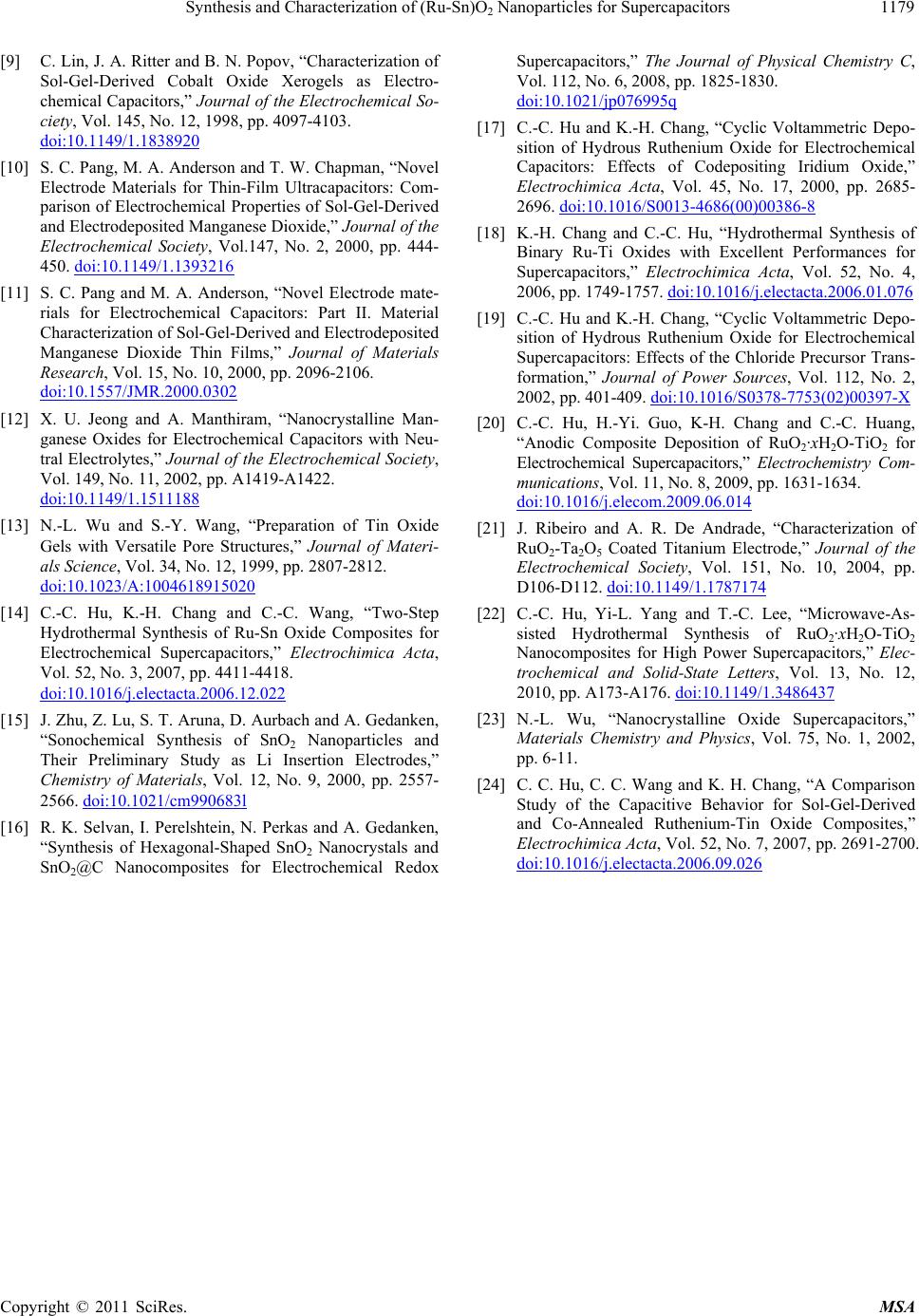
Synthesis and Characterization of (Ru-Sn)O2 Nanoparticles for Supercapacitors
Copyright © 2011 SciRes. MSA
1179
[9] C. Lin, J. A. Ritter and B. N. Popov, “Characterization of
Sol-Gel-Derived Cobalt Oxide Xerogels as Electro-
chemical Capacitors,” Journal of the Electrochemical So-
ciety, Vol. 145, No. 12, 1998, pp. 4097-4103.
doi:10.1149/1.1838920
[10] S. C. Pang, M. A. Anderson and T. W. Chapman, “Novel
Electrode Materials for Thin-Film Ultracapacitors: Com-
parison of Electrochemical Properties of Sol-Gel-Derived
and Electrodeposited Manganese Dioxide,” Journal of the
Electrochemical Society, Vol.147, No. 2, 2000, pp. 444-
450. doi:10.1149/1.1393216
[11] S. C. Pang and M. A. Anderson, “Novel Electrode mate-
rials for Electrochemical Capacitors: Part II. Material
Characterization of Sol-Gel-Derived and Electrodeposited
Manganese Dioxide Thin Films,” Journal of Materials
Research, Vol. 15, No. 10, 2000, pp. 2096-2106.
doi:10.1557/JMR.2000.0302
[12] X. U. Jeong and A. Manthiram, “Nanocrystalline Man-
ganese Oxides for Electrochemical Capacitors with Neu-
tral Electrolytes,” Journal of the Electrochemical Society,
Vol. 149, No. 11, 2002, pp. A1419-A1422.
doi:10.1149/1.1511188
[13] N.-L. Wu and S.-Y. Wang, “Preparation of Tin Oxide
Gels with Versatile Pore Structures,” Journal of Materi-
als Science, Vol. 34, No. 12, 1999, pp. 2807-2812.
doi:10.1023/A:1004618915020
[14] C.-C. Hu, K.-H. Chang and C.-C. Wang, “Two-Step
Hydrothermal Synthesis of Ru-Sn Oxide Composites for
Electrochemical Supercapacitors,” Electrochimica Acta,
Vol. 52, No. 3, 2007, pp. 4411-4418.
doi:10.1016/j.electacta.2006.12.022
[15] J. Zhu, Z. Lu, S. T. Aruna, D. Aurbach and A. Gedanken,
“Sonochemical Synthesis of SnO2 Nanoparticles and
Their Preliminary Study as Li Insertion Electrodes,”
Chemistry of Materials, Vol. 12, No. 9, 2000, pp. 2557-
2566. doi:10.1021/cm990683l
[16] R. K. Selvan, I. Perelshtein, N. Perkas and A. Gedanken,
“Synthesis of Hexagonal-Shaped SnO2 Nanocrystals and
SnO2@C Nanocomposites for Electrochemical Redox
Supercapacitors,” The Journal of Physical Chemistry C,
Vol. 112, No. 6, 2008, pp. 1825-1830.
doi:10.1021/jp076995q
[17] C.-C. Hu and K.-H. Chang, “Cyclic Voltammetric Depo-
sition of Hydrous Ruthenium Oxide for Electrochemical
Capacitors: Effects of Codepositing Iridium Oxide,”
Electrochimica Acta, Vol. 45, No. 17, 2000, pp. 2685-
2696. doi:10.1016/S0013-4686(00)00386-8
[18] K.-H. Chang and C.-C. Hu, “Hydrothermal Synthesis of
Binary Ru-Ti Oxides with Excellent Performances for
Supercapacitors,” Electrochimica Acta, Vol. 52, No. 4,
2006, pp. 1749-1757. doi:10.1016/j.electacta.2006.01.076
[19] C.-C. Hu and K.-H. Chang, “Cyclic Voltammetric Depo-
sition of Hydrous Ruthenium Oxide for Electrochemical
Supercapacitors: Effects of the Chloride Precursor Trans-
formation,” Journal of Power Sources, Vol. 112, No. 2,
2002, pp. 401-409. doi:10.1016/S0378-7753(02)00397-X
[20] C.-C. Hu, H.-Yi. Guo, K-H. Chang and C.-C. Huang,
“Anodic Composite Deposition of RuO2·xH2O-TiO2 for
Electrochemical Supercapacitors,” Electrochemistry Com-
munica tions, Vol. 11, No. 8, 2009, pp. 1631-1634.
doi:10.1016/j.elecom.2009.06.014
[21] J. Ribeiro and A. R. De Andrade, “Characterization of
RuO2-Ta2O5 Coated Titanium Electrode,” Journal of the
Electrochemical Society, Vol. 151, No. 10, 2004, pp.
D106-D112. doi:10.1149/1.1787174
[22] C.-C. Hu, Yi-L. Yang and T.-C. Lee, “Microwave-As-
sisted Hydrothermal Synthesis of RuO2·xH2O-TiO2
Nanocomposites for High Power Supercapacitors,” Elec-
trochemical and Solid-State Letters, Vol. 13, No. 12,
2010, pp. A173-A176. doi:10.1149/1.3486437
[23] N.-L. Wu, “Nanocrystalline Oxide Supercapacitors,”
Materials Chemistry and Physics, Vol. 75, No. 1, 2002,
pp. 6-11.
[24] C. C. Hu, C. C. Wang and K. H. Chang, “A Comparison
Study of the Capacitive Behavior for Sol-Gel-Derived
and Co-Annealed Ruthenium-Tin Oxide Composites,”
Electrochimica Acta, Vol. 52, No. 7, 2007, pp. 2691-2700.
doi:10.1016/j.electacta.2006.09.026